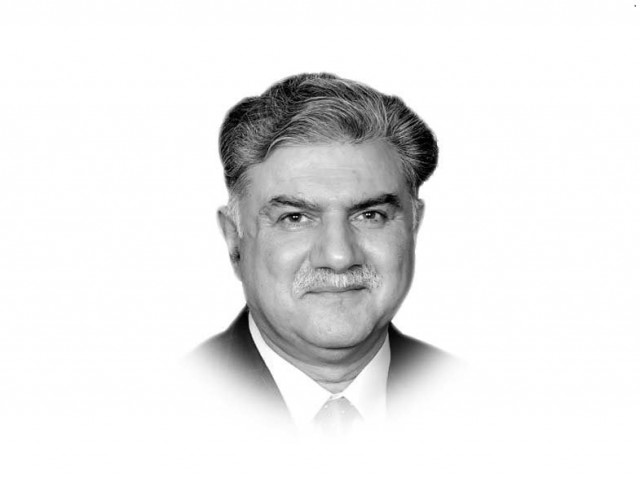Pakistan’s strategic construct — some thoughts
Without building regional stakes in our security/stability, Pakistan would continue to remain a security state

Powerful countries like the US, China and Russia have what military theorists call a ‘Grand Strategy’ and ‘other’ strategies including a Military Strategy. Strategies fall below policies in the modern state hierarchy. The strategic concept is amorphous and highly changeable from discipline to discipline. In purely military parlance, devising, implementing and sustaining strategies and grand strategies are highly complex phenomenon. Grand strategy (GS) and strategy are in essence, interrelationship and interface between means, ways and ends. Simply put, strategy is the employment of ‘means’ in optimum ‘ways’ to achieve the desired ‘ends’/objectives. Juggling with always limited means (essentially all elements of a nation’s power potential), to achieve desired end-state(s) is essentially an art as well as a science.
Strategy requires a logic, and logic generally rests upon assumptions; so, if assumptions are not sufficiently examined, the consequent strategy stands on weaker footings. An experienced strategist would always do due diligence to ensure that resources at hand are sufficient for the desired goals, once employed in optimal ways. ‘Tactics and operations’, going from lower to higher levels, deal with the employment of these resources (ways). In military phraseology, ‘tactics’ and ‘operations’ are subservient to strategy, hence the notion that strategic blunder cannot be corrected by tactical brilliance…an erstwhile divergence between the US and UK’s military thought process.
A Grand Strategy not only entails the employment of a nation’s own power potential (like military, economic, industrial, political, geographic, IT/media power, etc), it also brings in the commensurate powers of its allies and alliances (diplomacy in particular). Strategy, on the other hand, is more national in outlook and character. US/NATO strategies in the recent conflicts (Iraq, Afghanistan, Syria) were hence, grand strategies just like their erstwhile strategies in the World Wars. A GS influences and shapes regional and/or global landscape.
As per Clausewitz’s (1780-1831) theorem, ‘war is the continuation of policy by other means’, therefore, its practitioners — civil and military alike — should be schooled properly in its complexities. Politicians should have a working knowledge of the military, especially the shortfalls of its employment in complex political environment and its ‘bluntness’, and they should avoid the temptation of over-using the military; and the military hierarchy should be sensitive to political considerations and limitations of the politicians, democracy and political process. Any disconnect leads to fiascoes like the Afghan war (2001-2021). It is said that war is too serious a business to be left to the generals alone.
In theory, and as espoused by the NDU Islamabad, Pakistan’s overarching construct begins with a ‘National Purpose’… the raison d’être, or the very reason for which Pakistan exists. I will define it, “A separate homeland for Muslims fearing persecution in a Hindu India.” That purpose today stands validated, given the situation of Indian Muslims and Kashmiris in the Indian Union, under Modi’s RSS/Hindutva-laced rule.
The government translates the national purpose into concrete ‘National Interests’ (vital to peripheral, permanent to changing, primary to secondary, etc). Functions of ‘National Interest’ are translated into ‘National Aims and Objectives’. The ensuing ‘National Policy’, thereafter, blends national purpose and interests into actionable national objectives and guidance.
National Security Policy (NSP) generally enjoys primacy. It is heartening to see the recently released NSP-1/2022-2026 identifying just and peaceful resolution of Kashmir dispute as ‘a vital national security interest’.
Policy dominates strategy and each policy has to have a corresponding strategy. Whereas, policy ‘is a deliberate statement of objectives and guidance’, a strategy involves working plans across the envisioned spectrum of policy. Hence, the NSP would lead to other policies and strategies like economic, foreign affairs, trade and commerce, IT/media and internal policies and strategies, etc. The NSP would transcend into ‘Defence Policy’ (DP) and DP would end up into a ‘Military Strategy’, from where the respective Service Strategies would emanate.
Good to see that the process that started essentially by Dr Moeed Yusuf, the NSA, with Islamabad Security Dialogue (ISD) in March 2021 did not fizzle out. I had then alluded to Pakistan departing from the traditional notions of ‘national security’ towards ‘a more inclusive security construct’ comprising “economic progress, technological advancement, regional connectivity, knowledge entrenchment, and political stability.” Gen Bajwa had summed up the ISD highlighting the need for contemporary national security construct as citizen-centric “providing a conducive environment in which aspirations of human security, national progress and development could be realized.” One hopes that the official document of the NSP-1 contains the national strategic construct, as outlined above in entirety, having deliberated particularly upon our national interests, other than Kashmir.
To sum up the above debate; importantly, after identifying the NP (separate homeland due to existential fears), Kashmir resolution, peaceful neighborhood, human resource development, economic, organisational and infrastructural development, full-spectrum deterrence, debt retirement, domestic peace and stability, regional commerce/connectivity, freedom from terrorism plugging the many fault lines, could be ‘some’ of our national interests. Rule of law, strong defence, social and religious harmony, effective governance and regional trade could be ‘some’ of national objectives. And with the NSP out, the national security strategy could be debated.
Although smaller than most traditional powers, Pakistan can have a Grand Strategy, given its crucial location (at the seam of Central, South and West Asia), younger demographics, nuclear deterrence and alliance-power… being a bridge between Islamic and non-Islamic Worlds…a status it would ultimately acquire, negativity by the arm-chair intellectuals notwithstanding. Our ‘suggested’ GS could, therefore, be “while protecting ideological and territorial integrity, remain ‘positively relevant’ in the international system working diplomatically around problems, where Pakistan and the regional/global interests do not converge, owing to dictates of a changeable given environment.”
Pakistan was carved out of the erstwhile and competing Afghan, Indian and Iranian Empires alongside strong Central Asian influences. So, a strong Centre with credible defence capability remains our ‘centre of gravity (COG)’. However, economic prosperity, following a regional approach (through extended CPEC, SAARC, etc) ‘as an outer layer of our security’ is the ‘only’ panacea to dissolve our multifarious national fault lines, ensure peace and prosperity, and guarantee defence. Without building regional stakes in our security/stability, Pakistan would continue to remain a security state with lopsided economic expense and a military-dominant decision-making process. NSP-1 seems cognizant.
One hopes, the process of formulating national strategic construct, ushered in by the publication of NSP, is followed through, despite its many imperfections.
Published in The Express Tribune, January 20th, 2022.
Like Opinion & Editorial on Facebook, follow @ETOpEd on Twitter to receive all updates on all our daily pieces.
















COMMENTS
Comments are moderated and generally will be posted if they are on-topic and not abusive.
For more information, please see our Comments FAQ